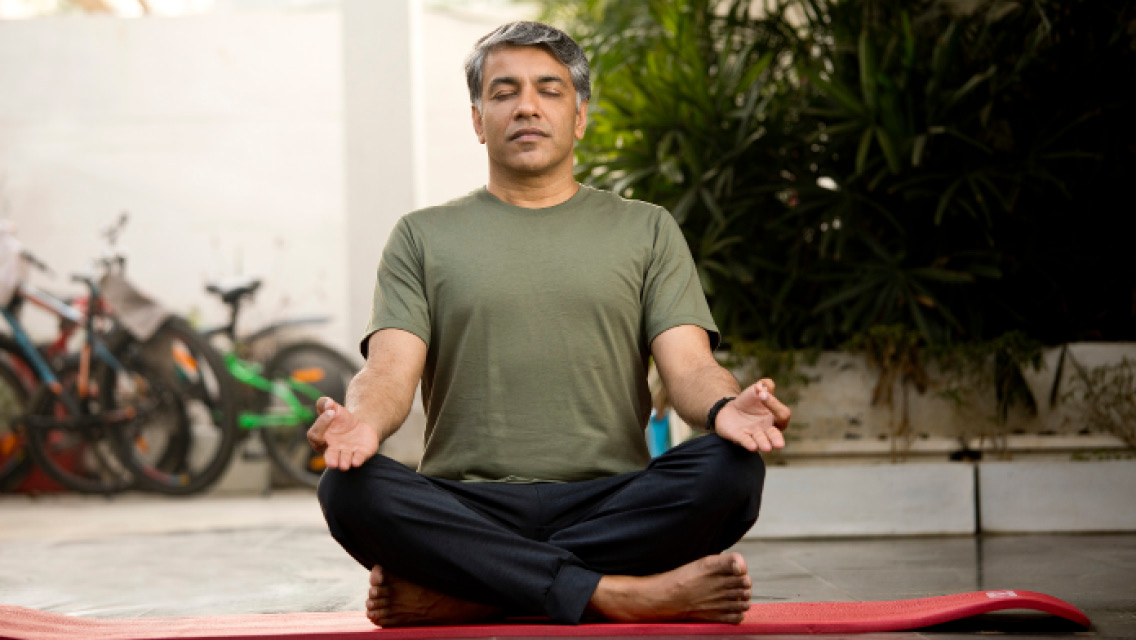It’s a Saturday morning in a chilly church rec room near the campus of the University of Minnesota in Minneapolis. About 30 men and women, ages 20 and up, sit in a circle, some on folding chairs, others cross-legged on the floor. Instructor Terry Pearson gently taps a bell three times, and its low tone slowly dissipates into silence. “Let the sound of the bell turn you inward,” she says.
Eyes closed, the group listens as Pearson leads them through a meditation, directing them to focus their wandering minds on their breathing. They are all taking part in a daylong meditation retreat, part of an eight-week course in mindfulness-based stress reduction (MBSR) – a technique that incorporates mindfulness meditation and gentle yoga.
The course is offered by the University’s Center for Spirituality and Healing. This well-attended class is indicative of the growing popularity of meditation in the United States today. No longer the domain of Buddhist monks and New-Agey types, meditation now appeals to mainstream business professionals, medical doctors and even healthcare companies, thanks in large part to the growing body of evidence that suggests a meditative practice can promote physical healing.
Researchers are learning how to explain the observable effects of meditation on today’s patients, but they’re also zeroing in on a better understanding of what meditation might be able to do – findings that could lead to more widespread and effective applications of meditation as medical treatment.
Train the Mind
Roughly 8 percent of Americans use meditation as a health tool, according to the National Center for Complementary and Alternative Medicine, part of the National Institutes of Health (NIH). In fact, meditation ranks as one of the top-10 alternative therapies used by the U.S. population (http://nccam.nih.gov/news/camsurvey_fs1.htm). The top alternative therapy is prayer – nearly half of all Americans say they pray regularly.
But while the focused thought involved in prayer can function as a form of meditation, scientists point out that prayer can be challenging to formally teach or study because its form and practice differ so markedly from person to person. Meditation, on the other hand, usually follows a highly teachable technique. Meditation may be a spiritual experience for some, but its practice isn’t necessarily religious in nature – agnostics and atheists, for example, may practice meditation.
There are many meditative approaches (see “A Matter of Mindfulness,” below), but regardless of technique, medical research shows that the practice of meditating tends to evoke a state of physiological relaxation: The heart beats more slowly, blood pressure drops and breathing becomes quieter. Biochemical changes also result. Scientists don’t fully understand why the changes happen. But understanding these physical effects is key to unlocking the potential health benefits of meditation, asserts Jeffery A. Dusek, PhD, instructor in medicine at Harvard Medical School and associate research director at the Mind/Body Medical Institute in Chestnut Hill, Mass., where researchers study the relaxation response.
“If we understand the biological mechanisms that are making changes in the meditators, we might better understand the conditions for which meditation might be useful,” he says. For example, if 20 minutes of daily meditation can provide relief from such ailments as headaches, low-back pain, depression and anxiety, people who suffer from these chronic problems might be able to incorporate the practice into their daily routine and feel better. Similarly, if meditation can lower blood pressure, it could be a useful tool to help hypertensive patients control their condition. Moreover, if scientists can understand exactly how meditation works to relieve these symptoms, they may be able to apply that understanding to unraveling or treating a host of other disorders, from diabetes to arthritis.
To Medicate or Meditate?
Research on meditation dates as far back as the late 1960s, when Herbert Benson, MD, began studying the physiological impact of Transcendental Meditation (TM) on individuals. (Benson went on to found the Mind/Body Medical Institute in 1988.) In recent years, however, there has been a dramatic upswing in the scope of studies delving into mind-body interventions. Much of the meditation research has focused on how the practice can help reduce symptoms of chronic illnesses, from cardiovascular disease to cancer.
Critics note that some of the research has been on small-study populations or hasn’t included adequate control groups for comparisons. Nonetheless, some of the studies have shown promising results. For instance, meditation may be particularly useful after surgery. A few years ago, University of Minnesota researchers began looking at MBSR’s effect on organ-transplant recipients. While medical advances have increased the survival rate for those patients, many still face lifelong chronic conditions, even if their transplanted organs function well.
The university’s pilot study, published in the May/June 2004 issue of Alternative Therapies in Health and Medicine, found that 19 organ-transplant recipients who completed the eight-week MBSR course reported a reduction in feelings of depression, anxiety and problems with sleeplessness. The course included instruction in proper standing, sitting and supine meditation, as well as gentle yoga. “With some of the patients, it had been three, four or five years since the transplant, but they still had difficulty sleeping,” says researcher Mary Jo Kreitzer, PhD, RN, who also directs the Center for Spirituality and Healing. “After being in the class for a couple of weeks, they noted an improvement.”
As a result of the pilot, Kreitzer and her colleagues received $2.1 million from the NIH to do a larger, five-year follow-up study. The study, currently under way, is an indication that even well-established institutions are increasingly interested in exploring the link between meditation and physical well-being.
Some researchers have gone to considerable lengths to investigate the potential healing effects of meditation. Robert Schneider, MD, director of the federally funded Center for Natural Medicine and Prevention at the Maharishi University of Management in Fairfield, Iowa, has done a dozen studies looking at the effect of TM on cardiovascular diseases, particularly among African Americans, whose risk of developing heart problems is particularly high. His studies have found that 20 minutes of TM twice a day can have a dramatic effect on patients’ health:
- One study, published in the journal Stroke in March 2000, found that patients with high blood pressure who practiced TM saw a decrease in the thickness of arterial walls in the neck, a problem that can lead to stroke.
- Another study, published in the American Journal of Hypertension in January 2005, found that hypertensive patients who used TM lowered their blood pressure more than those who used conventional techniques.
- A study published in the American Journal of Cardiology in May 2005 indicated that hypertensive patients who practiced TM tended to boost their longevity. One of TM’s greatest benefits, Schneider says, is that it offers a nonpharmacological prevention for heart disease, potentially reducing the need for patients to take drugs or undergo surgeries, both of which can have harmful side effects. His hypertension study, for instance, found that patients who used TM were able to reduce their use of anti-hypertensive drugs.Overall, Schneider says, he has observed a growing interest in mind-body interventions like meditation. “People are tired,” he says, “of modern medicine that doesn’t work.”
Inside the Brain
So how, exactly, does meditation affect the brain? That question is on the cutting edge of science today.
“Understanding what’s happening in the brain is important, because it’s related to what happens in the body,” says the Mind/Body Medical Institute’s Dusek. University of Wisconsin-Madison researchers made national headlines last fall when they announced the results of collaboration with the Dalai Lama to study the science of meditation. The researchers scanned the brains of eight of the lama’s followers to see what physiological effects their years of meditation might have had on the Buddhist monks’ brains. They measured gamma waves to compare the brain activity of the monks with that of novice meditators.
The study, published in November 2004 in the Proceedings of the National Academy of Sciences, found striking differences between the long-term and novice meditators, suggesting that, over time, the mental training acquired through meditation sculpts the brain just as physical training sculpts muscle. The monks’ brains showed dramatically increased activity in areas associated with positive emotions.
Dusek and his research team are doing similar research in Massachusetts, using functional magnetic resonance imaging (fMRI) technology to scan the brains of meditators for areas of increased activity and blood flow. They’re also measuring biochemical markers in meditators’ bloodstreams to explore the physiological reasons why blood pressure decreases during meditation. In time, Dusek says, this research on the brain and body may lead to better treatments of many conditions, possibly even untangling some complicated neurological disorders, such as Alzheimer’s disease.
For the moment, however, our scientific understanding of meditation’s measurable effects remains somewhat rudimentary. While it’s fairly well documented that meditation can relax the body, promote more restful sleep and boost the body’s immune system, for example – all of which, in turn, help fight illness and better manage the symptoms of chronic conditions – the mechanisms that trigger such physiological changes largely remain a mystery.
“The interest in meditation reflects a much broader interest that consumers have. They’re interested in taking charge of their health.”
And while we know that on a mental and emotional front, meditation can relax the mind and help us better deal with the stress of our daily lives, the neurological sea change that leads to such peace and relaxation is still a puzzle to scientists. “We still don’t know how meditation works, or why it works,” Kreitzer says. “That’s where the frontier of research is.”
The good news is that popular interest in meditation and its health benefits may help drive research in the future. When the Mayo Clinic began offering tips on meditation as a complement to some forms of therapy – a move it made earlier this year – medical researchers took note. Dusek says that, over the past 15 years, he’s noted an increasing interest in meditation on the part of both patients and scientists. Kreitzer agrees. “The interest in meditation reflects a much broader interest that consumers have,” she says. “They’re interested in taking charge of their health.”
A Matter of Mindfulness
Meditation can take many forms, yet researchers tend to focus on three similar and somewhat related types, each of which follow a teachable, easily replicated format. In each case, experts recommend practitioners meditate for at least 10 to 20 minutes once or twice daily.
- Mindfulness Meditation: This technique focuses on creating awareness of the present moment by paying nonjudgmental attention to the breath, body and changing perceptions as they enter the mind. The technique is taught in mindfulness-based stress reduction (MBSR) programs, which were originally devised by Jon Kabat-Zinn, PhD, founder of the Center for Mindfulness in Medicine, Health Care, and Society at the University of Massachusetts Medical School. For details, see www.contemplativemind.org/practices/subnav/mindfulness.htm.
- Relaxation Response: Herbert Benson, MD, first wrote about the physiological effects of relaxation-response meditation in his book The Relaxation Response. To elicit a relaxation response, meditators select a positive, calming word or phrase rooted in their belief system and repeat it silently to themselves while sitting in a quiet, comfortable environment. Examples include “one” or “peace,” or (if they prefer) a part of a prayer, like “The Lord is my shepherd.”
- Transcendental Meditation: Transcendental Meditation (TM) is an ancient Vedic practice introduced to the West by the Maharishi Mahesh Yogi. The popular method (millions worldwide have learned the technique) follows a specific, trademarked program in which meditators silently repeat a mantra – a word or phrase provided by the teacher – in order to clear the mind and achieve a state of restful alertness. For details, see www.tm.org.
Simple Remedy
Medical researchers are increasingly turning to meditation as a potential or supplemental treatment for fighting or preventing disease. Among the conditions and illnesses they’ve targeted:
Anxiety, Asthma, Cancer, Chronic pain, Coronary artery disease, Depression, Drug abuse, Fibromyalgia, Headache, HIV/AIDS, Hypertension, Irritable Bowel Syndrome, Organ transplantation, Psoriasis
Adapted from Complementary/Alternative Therapies in Nursing, fourth edition, Mariah Snyder, PhD, RN, FAAN, and Ruth Lindquist, PhD, RN, editors. Mary Jo Kreitzer, PhD, RN, wrote the chapter on meditation, from which this information was taken.




This Post Has 0 Comments